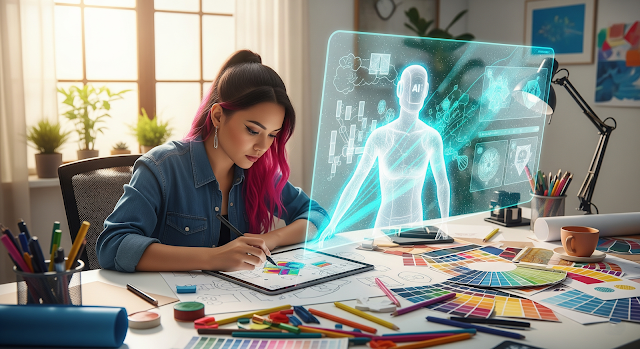The landscape of design is undergoing a dramatic transformation. Artificial intelligence (AI), once seen as a futuristic concept, is now becoming a fundamental part of the designer’s toolkit. As this technology continues to evolve, it’s clear that the future of web and graphic design will not be a competition between humans and machines—but a collaboration.
Rather than replacing designers, AI is poised to become a powerful creative partner. In this new era, human creativity and machine intelligence will work hand-in-hand to shape the future of design.
Automating the Repetitive, Enhancing the Creative
One of the most immediate benefits of AI in design is its ability to automate repetitive and time-consuming tasks. Actions like resizing images for different platforms, generating layout options, or organizing design assets can now be handled swiftly by AI-powered tools. This automation doesn't eliminate the designer—it frees them.
With more time available, designers can focus on the core of their work: creative thinking, storytelling, and problem-solving. AI enhances productivity, accelerates workflows, and reduces creative fatigue, making space for deeper, more strategic ideation.
A new era of Creative Exploration
AI doesn’t just make existing processes faster—it opens new doors to creative possibilities. Generative design tools can suggest layout variations, color palettes, or typography choices based on input preferences or brand guidelines. This expands the designer’s palette beyond what they could generate alone.
Designers can now use AI to:
-
Generate mood boards instantly.
-
Create multiple prototypes in minutes.
-
Use AI-trained models to analyze user behavior and suggest design improvements.
This isn’t about letting AI “take over” the creative process—it’s about augmenting human imagination with the speed and breadth of machine intelligence.
Human Strengths Meet Machine Capabilities
AI is not emotional. It cannot intuit cultural relevance or design with empathy. This is where human designers shine.
The future will demand that designers play a more strategic role—setting the vision, understanding user needs in context, and applying emotional intelligence to design decisions. Designers will guide the process, and AI will act as an efficient, responsive collaborator.
Evolving skill sets: The designer of tomorrow
To thrive in this evolving landscape, designers must adapt. Future-ready design professionals will need:
-
Proficiency in AI tools: From Adobe Firefly and Figma AI to custom GPT-based assistants.
-
Basic data literacy: Understanding how AI algorithms work helps designers make better creative choices.
-
Adaptability: The tools will change, but the ability to integrate new technologies will always be relevant.
-
Strategic thinking and empathy: The human side of design becomes even more important as AI handles more execution tasks.
Designers will become hybrid professionals—part visual thinker, part strategist, part technologist.
Designing with AI: Real-World Use Cases
AI is already enhancing web and graphic design in many ways:
-
UX/UI Optimization: AI analyzes user interactions and recommends design changes that improve usability.
-
Personalized Experiences: Dynamic, AI-driven content adapts to individual users in real time.
-
Brand Design at Scale: AI can generate brand assets across hundreds of formats, maintaining consistency.
-
Visual Accessibility: Tools now help designers identify contrast issues and suggest accessible alternatives instantly.
This is just the beginning. As models continue to learn and improve, their contribution to the creative process will deepen.
The future is collaborative
Rather than fearing AI, designers must embrace it as a partner in innovation. By combining human emotion, intuition, and cultural understanding with the speed, data-processing power, and pattern recognition of AI, the future of design becomes more expansive and inclusive.
AI will not steal creativity—it will expand its boundaries.
Conclusion: Designing a Better Future
The role of the designer is evolving—not disappearing. The future belongs to those who can master tools, adapt with agility, and lead with imagination. By embracing AI as a creative partner, designers can elevate their craft, amplify their impact, and shape a future where technology serves creativity—not the other way around.
The future of design is not AI vs. human—it's AI + human. Together, they’re capable of designing experiences we’ve only just begun to imagine.

Comments
Post a Comment